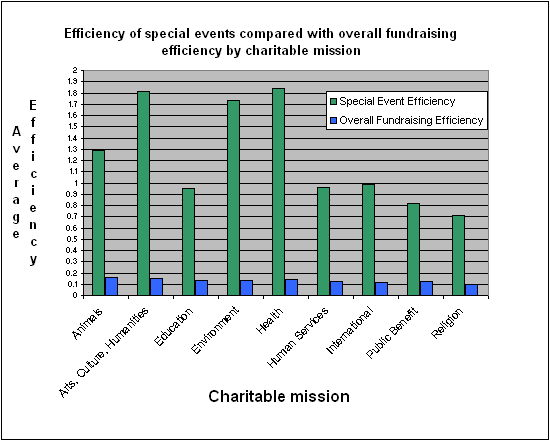Are Special Events worth it?
I have been asking this question ever since I ran my first event (an auction that took me several months to plan, on which we spent about $40,000 in order to get a net return of $25,000). However, my boards and chief executives have always justified the events by "the intangibles":
- Public awareness of our work,
- Bringing in new money,
- Rewarding current donors (i.e. building relationships).
However, this new 2007 Special Events Study from Charity Navigator provides some very interesting data to answer the question of: "Are events worth it?"
Here is a sample graph that shows how inefficient these special events are compared to other forms of fundraising:

I do believe that there are benefits to special events that go beyond the bottom line. However, as fundraisers, we must consider this bottom line -- and if we are going to justify events because of their long-term impact, then we need to look at the annual return for our organization. If we justify an event by saying it creates long-term returns and yet our annual fund is not increasing every year, then we are kidding ourselves.
Here are some additional considerations that need to be included within any analysis of events:
- Compensation provided to event staff who work on the events. If your event raises $100,000, but your Development Director spends 30% of their year working on the event, then you need to deduct her salary from the return.
- Compensation provided to executive/administrative staff. Any event will likely pull away time from the CEO, the Controller, and other staff. These costs should be reflected as well.
Additionally, we need to consider the possible downsides of having an event:
- Opportunity Costs for Development Team. Rather than writing grants or meeting with donors, staff are busy picking out table decorations and working with vendors. The amount of "lost fundraising" is an opportunity cost that must be considered.
- Opportunity Costs for Volunteers. Although events provide volunteers with a great opportunity to bring their friends into the mission, they are also a great "out" for Board members (i.e. "I bought my tickets to the gala, so I don't have to donate" or "I filled my table at the breakfast, so I don't need to recruit any new donors."). The end result could be less successful cultivation than if every board member were responsible for leading one tour per year for their contacts.
- Negative brand impacts. Donors don't like it when organizations spend money on fundraising. When you have a big flashy event that nets less than 50% of its total revenue, you are going to make some people mad -- particuarly sophisticated donors who dig into your financials.
- Negative messaging. Big flashy events do not connote need. They convey an image of financial strength. I have heard several donors say that they "did not know that we needed money." Literally, those were their words. This is hardly what I want them to think at the end of the year when they are thinking about which organizations to support!
- They're a beating. Staff and volunteers can get worn out from doing an event. Every year, we have a big event right around the time when our United Way proposal are due. By the time we get through everything, the development team wants to take a month off... which is not exactly the ideal scenario, particularly towards the end of the year when we need to make our big push to close gifts from donors.
And yet, despite all of this info, it is rarely the fundraiser's call about whether or not to have an event. Our Boards still want them, and our Executive leadership still wants them.
"So we beat on, boats against the current, borne back ceaselessly into the past."
- F. Scott Fitzgerald

